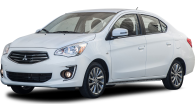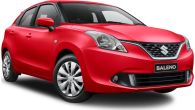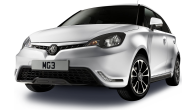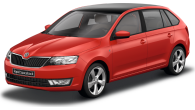The N15 Pulsar was an all-new, fully imported, fifth-generation model that arrived on these shores in 1995.
Compared to its popular predecessor it was longer and wider, which together with a longer wheelbase, resulted in more cabin space.
.jpg)
Models
Typical of the era, its looks weren't very exciting, but there was still a lot to get excited about.
Like its predecessor it was offered as a four-door sedan and a five-door hatch, with four main models; the LX, Q, SLX, and SSS, plus a limited-edition Plus.
Most models had a 1.6-litre four-cylinder engine, and the choice of a manual gearbox or automatic transmission, the exception being the sporty SSS hatch, which had a 2.0-litre four-cylinder engine.
The LX sedan and hatch opened the door to the N15 Pulsar offering with a rather limited range of standard features that included central locking, cloth trim, power mirrors, power steering and a radio/cassette player with two speakers. Air-conditioning was optional.
One of the most popular models in the range was the Q hatch, a value-for-money proposition that added sports seats and an airbag for the driver. Air-conditioning was optional.
The SLX sedan was the range-topper, and befitting its lofty position it had additional standard features like air-conditioning, power windows, a leather steering wheel and four speakers for the radio/cassette player.
But for excitement there was the SSS hatch, which gave buyers ABS anti-lock braking, sports seats, a CD player, front fog lamps and a leather steering wheel.
A limited-edition Plus model was added in 1997, which could be had as a sedan or hatch, and came with air-conditioning, alloy wheels, central locking, cloth trim, power mirrors, power steering, a radio/cassette player with two speakers, and a rear spoiler.
.jpg)
That followed in 1999 with a Series II update, which was best identified by new grilles, taillights and trim materials.
The LX now had a driver's airbag, air-conditioning, a trip computer, remote central locking, a CD player (in addition to the radio/cassette player) with four speakers, and a remote boot release.
There was more for the Q, too. It got air-conditioning, alloy wheels, a CD player, remote central locking, trip computer, remote boot release and power windows.
Added to the features of the SLX were ABS anti-lock braking, alloy wheels, a CD player, trip computer, remote central locking and a trip computer.
Similarly the SSS had remote central locking, a remote boot release and a trip computer.
The N15 Pulsar predated features like Bluetooth, which meant you couldn't connect an iPhone or an Android device, nor did it have sat nav or a touchscreen, and while it had air-conditioning, it wasn't climate control.
Parking the N15 Pulsar had to done without the aid of parking sensors, a reversing camera, or a park assist system. But the spare tyre was a full-sized wheel.
.jpg)
Cabin
The cabin was a good mix of practicality and attractive touches, particularly the SSS with its sports front seats and leather-wrapped gear knob and steering wheel. The multi-adjustable steering column made it easy to find the optimum driving position.
Thanks to its larger external dimensions, the N15 Pulsar boasted a roomier cabin than that of its predecessor. As a result, those in the front and back seats were treated to more leg and shoulder room, making for a much more comfortable ride.
With its split-fold rear seat, the Pulsar offered generous luggage space, particularly when the seat was folded. The cabin layout was neat, too, with controls well placed and within easy reach of the driver.
Fitting a baby car seat was facilitated by lap/sash seat belts, but it was too early for ISOFIX child car seat mounting points.
.jpg)
Engine
All models bar the SSS had a 1.6-litre double-overhead camshaft engine, with four valves per cylinder and electronic fuel injection. When at its peaks of power and torque it produced 86kW and 147Nm, enough to make it surprisingly zippy.
The SSS was a serious small sporting hatch with a handy power-to-weight ratio of 10.87kg/kW in its base form, which was the key to its zippy performance.
Power for the SSS came from Nissan's willing SR20DE 2.0-litre double overhead camshaft four-cylinder engine that boasted four valves per cylinder and fuel injection. At its twin performance peaks it put out 105kW, or 140 horsepower, at 6400rpm, and maximum torque of 179Nm at 4000rpm.
That was enough to cover the 0-100 km/h sprint in 8.7 seconds. It could account for the standing 400m sprint in about 16.5 seconds, and reach a top speed in excess of 180 km/h. It was indeed a hot hatch.
Both engines used 91-octane regular unleaded petrol. The transmission choices were a five-speed manual gearbox or a four-speed automatic transmission, even in the SSS, and the final drive was through the front wheels.
Driving
.jpg)
With a mix of MacPherson Strut front suspension and multilink beam rear suspension, and anti-roll bars front and rear, the Pulsar's handling was sharp and precise.
Performance from the 1.6-litre engine was perfectly adequate for the everyday commute, delivering a useful mix of flexibility and get up and go that could easily handle town traffic.
The 2.0-litre engine in the SSS elevated the performance to a higher level. It wasn't the blistering performance of some other hot hatches, but it was sufficient to lift the Pulsar into another league and provide the driver with an engaging drive experience.
Safety
.jpg)
The N15 Pulsar was given a one-star rating for driver protection in the How Safe Is Your Car survey of real life crashes.
Safety features were few; the LX didn't have any airbags when it was first launched. The Q, SLX and SSS were better equipped, and had an airbag for the driver. ABS anti-lock braking was only available in the SSS.
After the Series II update in 1997, all models had a driver's airbag, but only the SLX and SSS had the benefit of ABS.
When shopping for an N15 Pulsar today, the Series II offers the best safety package.
Any common issues?
There are no major reliability issues to be concerned about with the N15 Pulsar, it has a fine reputation for going, and going, and going. The engines, transmissions and drivelines are sturdy and give little trouble.
Still, with a car as old as the N15, it's vital that they be thoroughly inspected and evaluated. An ageing car is much more likely to give trouble than one that is fresh from the production line.
It's to be expected that normal wear and tear will cause parts to fail or wear out. Uncaring drivers can accelerate the wear and tear simply by abusing or neglecting their cars.
Have any car under consideration examined by a mechanic to establish the actual mechanical condition, and check for a service record that shows regular routine maintenance.
Both engines have timing chains, so there's no call for regular servicing. The new car warranty that applied to the N15 Pulsar was for three years/100,000km.
The N15 came in before the introduction of capped price servicing, but there's nothing that should make the service costs excessive.
If anything else crops up, you'll probably find it on our Nissan Pulsar problems page.
.jpg)
Owners view
Jill Thomas: I bought my Plus sedan in 2014 and it's been great, even though it has done almost 200,000km. It goes well, is cheap to run, and good value.
Allan Allsop: I bought my 1999 Plus hatch in 2005 when it had done 90,000km. When I sold it in 2017 it had done 375,000km and was still going strong. The performance was surprisingly good, so was the handling, and it never missed a beat.
Sophie Taranto: My Plus sedan has been awesome. It's done 300,000km and virtually nothing has gone wrong with it in the nine years I've had it. It's fast for a small car, and it's easy to drive, and it just keeps going.
Paul Matthews: My 1999 Plus sedan had 200,000 km when I bought it four years ago. The handling was great, and economy surprisingly good.
Verdict
Good, reliable small car, but few safety features make it a questionable buy for young drivers.
Rating
2.5 stars.
Rivals
Toyota Corolla – Well built, well designed, hard to beat.
2.5 stars.
Mitsubishi Lancer – Good buy if in top condition with low kilometres and a credible service history.
2 stars.
Ford Laser/Mazda 323
Badge brothers worth considering if in decent shape.
2 stars.
Nissan Pulsar 1995: LX
| Engine Type | Inline 4, 1.6L |
|---|---|
| Fuel Type | Unleaded Petrol |
| Fuel Efficiency | 8.0L/100km (combined) |
| Seating | 5 |
| Price From | $2,640 - $4,070 |
Pricing Guides

.jpg)

.jpg)

.jpg)





































.jpg)

